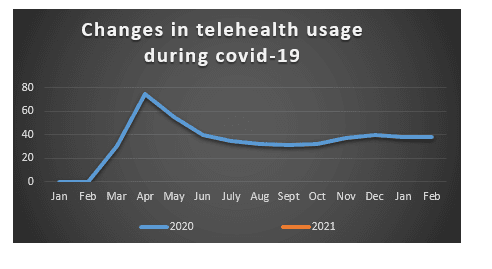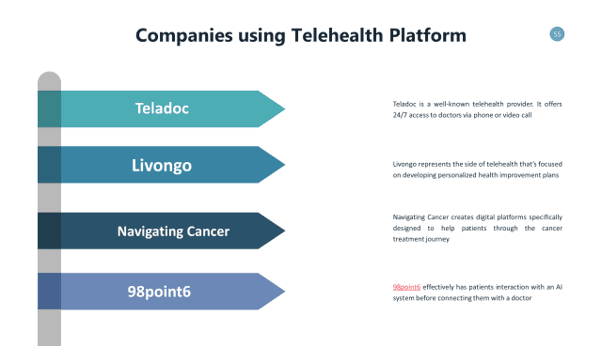遠距醫療的崛起:透過數位通訊轉變醫療保健
在 COVID-19 之前,您是否知道可以使用數位通訊諮詢您的健康狀況?我們大多數人並不相信線上諮詢的過程,但現在已經發生了一些變化,以增強醫療保健產業中的遠距醫療。
什麼是遠距醫療?
遠距醫療定義為提供和協助健康和健康相關服務,包括醫療照護、提供者和患者教育、健康資訊服務,使用電子方式診斷、治療和預防疾病和傷害、研究和評估,以及醫療保健提供者的教育。即時視訊會議、行動健康應用程式和遠端患者監測 (RPM) 是透過電腦和行動裝置(例如平板電腦和智慧型手機)在遠距醫療中使用的技術範例。它為有健康問題的個人提供了一種方便且經濟高效的方式,讓他們可以在舒適的家中尋求醫療照護。
COVID-19 期間的遠距醫療
冠狀病毒的突然傳播限制了個人在人群中移動,並減少了全球範圍內的互動。因此,遠距醫療成為一項重要的醫療保健服務,可幫助個人與服務提供者聯繫並診斷他們的問題,並導致面對面護理迅速轉變為遠端諮詢,因為對遠距醫療技術的需求和使用量大幅增加。在這種情況下,從業人員被迫轉向遠距醫療,以便為患者提供卓越的護理。
COVID-19 如何為遠距醫療帶來改變?
現在最突出的是,遠端患者護理比以往任何時候都更容易獲得。在數位化和遠距醫療的幫助下,在短時間內接受慢性疾病的治療變得更加容易,例如內分泌學、風濕病學、腸胃病學、精神科諮詢和整體長期護理。遠距醫療技術有助於減少患者接觸其他病患的機會。

公司正在將遠距醫療途徑推向市場
在冠狀病毒激增之後,我們都知道,醫療保健行業對資源的需求在過去幾年中呈爆炸式增長,這為許多公司創造了一個轉型途徑,使其專注於醫療保健和增強醫療保健系統的技術。以下列出了一些透過其平台提供各種技術的公司:
- 23andMe:23andMe 使用一個人的基因來確定他們有患哪些疾病的風險,並制定支持計劃來幫助他們避免或控制這些疾病
- Amazon:遠距醫療與電子商務平台並不產生共鳴,但亞馬遜最近為亞馬遜員工建立了一項名為 Amazon Care 的遠距醫療服務。
以下列出了一些其他公司及其平台:

遠距醫療全球市場:
根據 The Business Research Company 的說法,全球遠距醫療市場預計將從 2020 年的 830 億美元增長到 2025 年的 3190 億美元,複合年增長率 (CAGR) 為 30.9%。 預計該市場將在 2030 年增長到 5210 億美元,複合年增長率 (CAGR) 為 10.3%。 快速增長可歸因於在封鎖期間對 COVID-19 和其他疾病的診斷中對遠距醫療服務不斷增長的需求。
挑戰與機會:
很明顯可以看出,患者如何從遠距醫療服務中受益,因為他們可以更容易地獲得護理,同時可以在家中接受治療。 與過去幾年相比,患者的參與率也更高,因為患者的焦慮程度較低,這也減少了等待時間,因此提供者可以治療和接觸更多患者。
儘管提供了許多好處,但在將其整合到醫療保健和保險行業時,仍面臨某些挑戰。 其中報銷是遠端醫療的最大挑戰之一,醫療保健提供者的可擴展性挑戰尚未克服,如果醫療保健組織缺乏下一代基礎設施,實施、解決和擴展遠距醫療的好處將變得極其困難。 此外,一般來說,還有一些尚未解決的主要問題,如下所示:
- 安全性:與許多數位技術一樣,遠距醫療引發了對隱私和患者資料安全性的擔憂
- 意識:患者經常難以解決的遠距醫療挑戰是缺乏意識或理解。 如果他們不知道有這個選擇,他們可能永遠找不到方法來接觸它
- 存取:仍然患者可能無法存取有效利用它所需的技術,即使他們可以存取必要的技術,他們也可能難以正確使用它
作者:Riya Singh
